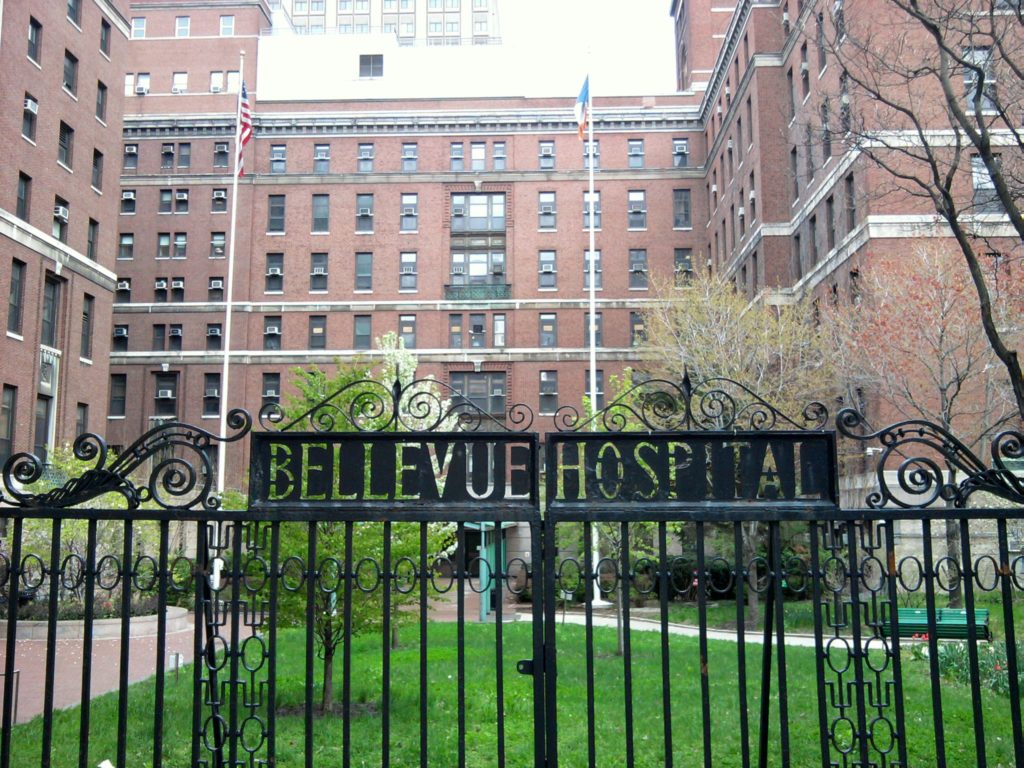
Published April 7, 2017
Take a stroll, if you dare, through the bowels of Bellevue, New York City’s flagship public hospital. You might mingle with prisoners in orange jumpsuits and handcuffs; some may spit or curse at you. Ride the elevator down, and you will stare in horror as an agitated drug addict with an infection tries to punch a physician while bolting out of his hospital room with security guards and nurses in pursuit. Next door, a homeless patient lies in bed with heart failure. Next to him is a patient who’s visiting New York from Africa with a raging AIDS infection. Peer into another room down the hall, and you can watch patients withdrawing from alcohol or heroin, thrashing about and screaming.
If you believe in ghosts, perhaps you can shake the hand of jazz musician Charlie Parker, who committed himself at Bellevue after two suicide attempts in 1954, or say hello to poet Sylvia Plath, who was admitted after suffering a nervous breakdown. Norman Mailer, the renowned novelist who was committed to Bellevue after stabbing his wife, may brush past you. If you have the courage, you can face down John Lennon’s assassin, Mark David Chapman—or even John Lennon himself, whose body was brought to the Bellevue morgue.
Bellevue is not for the faint of heart. In addition to celebrities, its clinicians treat undocumented immigrants, the homeless and destitute, drug and alcohol addicts, and criminals. Stories of these encounters only serve to reinforce the difficult task of providing medical care to those without resources. Indeed, the hospital expects no remuneration for its efforts if one cannot pay, whether patients require brain surgery or simply a warm meal.
This is an unusual modus operandi in a healthcare system that has few resources for such altruistic causes. But Bellevue has operated in this way since its very inception, acting as the hospital of last resort for New York City and for America’s neediest and most troubled, as David Oshinsky reminds us in his fascinating new history of the institution, Bellevue: Three Centuries of Medicine and Mayhem at America’s Most Storied Hospital. Professor Oshinsky, Pulitzer Prize-winning author of Polio: An American Story and professor of history at NYU, eloquently tells the hospital’s history from its humble beginnings to its subsequent accomplishments and horrors.
Oshinsky’s comprehensive book arrives at a time when the public hospital system’s difficulties are compounded by our healthcare system’s financial hardships and confusion, calling into question whether supporting such institutions is worth the investment. His history, however, is less a cheerleading polemic and more a fascinating tale, demonstrating that Bellevue’s past and present are equally unsettling, remarkable, and enduringly relevant.
The Early Years
According to records from the West India Company, Bellevue’s existence can be traced back to an infirmary in Manhattan in the 1660s for soldiers who were “overcome ‘by bad smells and filth.’” In 1736, the British turned it into an almshouse with a “room for the sick and the insane.” By 1795, it had expanded to house nearly eight hundred paupers. With a burgeoning New York population and the spread of Yellow Fever, its commissioners sought a larger space in Bel-Vue, a parcel of land in Manhattan, named for its view of the East River and the surrounding fields.
As the Yellow Fever epidemic reached its peak, Bellevue hired its first resident physician, the twenty-year-old Dr. Alexander Anderson. The job took its toll on Dr. Anderson, as he watched hundreds of patients die: “Although I was employed night and day and even assisted in opening four dead bodies, I escaped the infection, but suffered from a depression of spirits.”
One resident physician was clearly not enough for so many patients, nor was the larger space sufficient. New York ran a lottery to raise money for Bellevue’s expansion and opened the reconstructed institution in 1816. Timothy Dwight, Yale University’s president, said of it: “There is no eleemosynary establishment in the American Union equally splendid.” Bellevue used materials for its construction from Federal Hall, where Washington took the first presidential oath of office in 1789: embroidered wrought iron railings, a gold-plated weathervane, and a stone on which George Washington stood.
But the expansion of facilities like Bellevue, Oshinsky explains, was not enough to improve sanitary and public health conditions in New York City. With an influx of poor immigrant families came disease, overcrowding, and death. In 1832, cholera—a deadly illness that causes bouts of unremitting diarrhea—arrived in New York, affecting Irish immigrants most severely. Vermin also thrived. The New York Times reported that rats “swarm at the water side after nightfall, crawl through the sewers and enter the hospital.” The Times piece told the story of rats eating a deceased baby on the wards: “The nose . . . upper lip and a portion of the cheeks seemed to be eaten off. The toes of the left foot and a portion of the foot were eaten off, or apparently so. The lacerated portions were covered with sand and dirt.”
Clearly, though Bellevue was becoming the largest hospital in the United States, in many respects it remained the same institution where Dr. Anderson had toiled: an overcrowded and frightening refuge for the indigent.
Making an Impact
Yet far-reaching changes did eventually come to Bellevue. In 1841, Dr. Valentine Mott, a world-famous surgeon, gathered leading physicians to establish a medical school at New York University where students and faculty would have full access to Bellevue. Dr. Mott thus added a strong academic force to the hospital and provided valuable and diverse clinical experience to trainees, a tradition that continues to this day.
Soon, Bellevue found itself playing a burgeoning role in the American political scene. During the Civil War, the Union Army sent many of its wounded back to a short-staffed Bellevue for medical care, prompting the Union’s top commander, General George McClellan, to visit soldiers at the hospital multiple times. When John Wilkes Booth assassinated Abraham Lincoln at Ford’s Theater, Dr. Charles August Leale, a graduate of Bellevue’s medical school, was the first to attend to Lincoln, locating the fatal bullet hole behind Lincoln’s ear and staying with the President until the bitter end, “feeling for his pulse and gently massaging his hand.” When asked why he remained with Lincoln, Dr. Leale replied: “Sometimes recognition and reason return just before departure. . . . I held his hand firmly to let him know, in his blindness, that he had a friend.”
Bellevue also provided unexpected creative opportunities. In 1867, the hospital established a Photographic Department, and Oscar Mason, a thirty-seven-year-old portrait photographer, took pictures of anonymous Bellevue corpses and hung them up so family members could identify dead relatives. It was appropriately named the “Wall of the Unknown Dead.” He subsequently created the first criminal mugshot in the 1870s, which he modeled after the Wall.
Beyond the political and artistic scenes, Bellevue made an impact on medical research. In the early twentieth century, an exposé of the local coroner’s office in NYC found it to be endemic with “favoritism, extortion, and malfeasance” where crimes of “infanticide and skilful poisoning” went undiscovered due to the lack of medical data. New York subsequently abolished the old system where non-medical professionals acted as coroners. The first physician to occupy the new post was Dr. Charles Norris, director of laboratories at Bellevue Hospital. Norris revolutionized forensic medicine, devising ways to, in Oshinsky’s words, “examine semen stains on clothing, trace the trajectory of a bullet, detect minute levels of different poisons in the system, and then determine the body’s exact tolerance for each one of them.” Norris’ partner, Alexander Gettler, performed remarkable and grotesque experiments to further this area of science. For instance, to determine whether a human body that washed ashore died from falling drunkenly or had been dumped in the water already dead, Gettler drowned a number of dogs and performed autopsies on them. Eventually, he found that because water in the lungs enters the heart’s left chamber before entering the body’s circulation, someone who drowned and whose heart continued to beat as the patient drowned would have different levels of salt water in the circulation than someone who was thrown into the water already dead.
Bellevue physicians made important medical advances in less gruesome specialties as well. In 1956, Drs. André Frederic Cournand and Dickinson Richards won the Nobel Prize in medicine for their work on cardiac catheterization. Cardiologists now use this procedure daily to save lives.
Despite these historic contributions, Bellevue continued to have a reputation as a dark and morbid institution. To be sure, there were good reasons for this. In 1989, Steven Smith, a homeless cocaine addict squatting in Bellevue, murdered Dr. Kathryn Hinnant, a pregnant young pathologist, in her office. The hospital swelled with the undomiciled during this time, too. As one physician said, “Wintertime was the worst. . . . The cold weather drove the homeless into the hospital, and all of Bellevue seemed a fetid, overcrowded, wretched purgatory to which we were committed to the end of our residency . . . if ever that would arrive.”
Even after closing down during Hurricane Sandy in 2012 and reopening with a fresh start, Bellevue presented challenges similar to those originally faced by Dr. Anderson, such as a lack of resources, crowded floors, and a sometimes-sinking morale. Oshinsky concludes, “There never was a time when Bellevue appeared even remotely trouble free.”
A Realistic Appraisal
Professor Oshinsky’s history bursts at the seams with enthralling stories about Bellevue. And it is clear by the end of his shockingly veracious tale that Bellevue’s role in America has been far more than simply that of a sensationalist psychiatric institution.
What do these stories tell us about our current healthcare system? US spending on healthcare encompasses approximately 18 percent of GDP. Amongst other developed countries, the average GDP expenditure on healthcare is 8.9 percent. And rising healthcare costs have hit New York’s hospitals hard. From 2008 to 2014, Health and Hospitals Corporation, the municipal administration under which Bellevue and other NYC public hospitals operate, lost more than half a billion dollars annually. It is facing three billion dollars in lost revenue between 2017 and 2024, with a projected deficit of one and a half billion dollars before the end of this decade. As we read Oshinsky’s work, we must ask: how important is Bellevue and her history, given the costs to the system? Is it worth keeping afloat an institution with such a checkered past?
Oshinsky never answers these questions directly. It is clear how much he admires Bellevue, yet he never hides its warts. Indeed, as Oshinsky’s book so rightly demonstrates, one doesn’t have to romanticize the institution to appreciate its place in history. Yes, Bellevue’s past is filled with tragedy and financial hardship. But that history is also married to scientific discovery, American history, immigration, medical education, and charitable medical care. Not all of these contributions are quantifiable, but some are immediately apparent—think of the hundreds of medical students, nursing students, residents, and patients who pass through the hospital every morning. Few other institutions can expose residents to such a diverse patient population and constellation of diseases, and few other institutions exist where physicians offer medical care without asking for identification or a home address.
With all its faults, Bellevue has a lot to show for its grand aspirations. Whatever becomes of our crumbling healthcare system, we should do whatever we can to salvage and improve Bellevue. Our patients still need it and we, as physicians, need it . After all, Bellevue reflects the worst and the best, not just of its disadvantaged patients, its physicians, and its students, but of the American democratic project.









